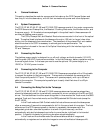Section 3 - At the Telescope with a CCD Camera
Page 21
One of the reasons that SBIG autoguiders are often better than human guiders is that,
rather than just stabbing the hand controller to bump the guide star back to the reticule, it gives
a precise correction that is the duration necessary to move the guide star right back to its
intended position. It knows how much correction is necessary for a given guiding error
through the Calibrate Track command. The Calibrate Track command, which is used prior to
autoguiding, exercises the telescope's drive corrector in each of the four directions, measuring
the displacement of a calibration star after each move. Knowing the displacement and the
duration of each calibration move calibrates the drive's correction speed. Once that is known,
the CCD tracker gives the drive corrector precise inputs to correct for any guiding error.
When self guiding is selected by invoking the Self Guiding command under the Track
Menu, the computer prompts the user for the exposure time for the tracking and imaging
CCDs. Once these are entered, the computer takes and displays an image with the tracking
CCD, and the user selects a guide star using the mouse. Guide stars that are bright, but not
saturating, and isolated from other stars are preferred. Once the star is selected, the computer
starts guiding the telescope. When the telescope corrections settle down (usually once the
backlash is all taken up in the declination drive) the user starts the exposure by striking the
space bar. The computer then integrates for the prescribed time while guiding the telescope,
and downloads the image for display.
A calibration star should be chosen that is relatively bright and isolated. The calibration
software can get confused if another star of comparable brightness moves onto the tracking
CCD during a move. The unit will self guide on much fainter stars. Tests at SBIG indicate that
the probability of finding a usable guide star on the tracking CCD is about 95% at F/6.3, in
regions of the sky away from the Milky Way. If a guide star is not found the telescope position
should be adjusted, or the camera head rotated by a multiple of 90 degrees to find a guide star.
We recommend that the user first try rotating the camera 180 degrees. Rotating the camera
will require recalibration of the tracking function.
3.9.5. Auto Grab
The Auto Grab command allows you to take a series of images at a periodic interval and log
the images to disk. This can be invaluable for monitoring purposes such as asteroid searches
or stellar magnitude measurements. You can even take sub-frame images to save disk space if
you don't need the full field of view.
3.9.6. Color Imaging
The field of CCD color imaging is relatively new but expanding rapidly. Since all SBIG
cameras are equipped with monochromatic CCDs, discriminating only light intensity, not
color, some provision must be made in order to acquire color images. SBIG offers a color filter
wheel, the CFW-8, which provides this capability for the ST-7E, ST-8E, ST-9E and ST-10E.
The color filter wheel allows remotely placing interference filters in front of the CCD in order to
take multiple images in different color bands. These narrow band images are then combined to
form a color image. With the SBIG system, a Red, Green and Blue filter are used to acquire
three images of the object. The resulting images are combined to form a tri-color image using
CCDOPS, CCDSoftV5 or third party software.


















